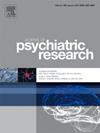对他人身体的评价配对能否间接改善对身体的不满意?一项针对成年女性的随机对照在线研究。
IF 3.7
2区 医学
Q1 PSYCHIATRY
引用次数: 0
摘要
目的:身体不满意是导致饮食失调的一个重要风险因素。本研究调查了将体重正常 "健康 "的女性身体图像与积极刺激配对,以及将体重超出健康范围(如体重不足)的身体图像与中性刺激配对,是否能改善身体不满意度:我们比较了 121 名成年女性的行为数据和评分数据,这些女性参与了一项在线研究,并被随机分配到干预条件(健康体重预示着积极刺激)或对照条件(体重和刺激效价之间不存在或然性):行为数据显示,与对照组相比,干预组的女性学会了将健康的身体与积极的情绪联系起来。反过来,学会了将健康的身体与积极的情绪联系起来,也预示着身体不满意度的降低。干预条件和对照条件与身体不满意度的变化没有直接关联:学会将健康的身体与任何积极的刺激联系起来可能是理解和预测女性身体不满意度改善的相关机制。关于应急学习对评价其他身体的影响,以及在与身体有关的社会比较过程中选择其他身体的影响,还需要进一步研究。本文章由计算机程序翻译,如有差异,请以英文原文为准。
Can evaluative pairings of others’ bodies improve body dissatisfaction indirectly? A randomized-controlled online study with adult women
Objective
Body dissatisfaction is an important risk factor for developing eating disorders. This study investigated whether pairing images of normatively “healthy” weight bodies of women with positive stimuli, and images of bodies outside the healthy range (e.g., underweight) with neutral stimuli, could improve body dissatisfaction.
Methods
We compared behavioral and rating data from 121 adult women who participated in an online study and were randomly assigned to an intervention condition (in which healthy body mass predicted positive stimuli) or a control condition (with no contingency between body mass and stimulus valence).
Results
Behavioral data showed that women in the intervention condition, compared to the control condition, learned to associate healthy bodies with positive valence. Having learned to associate healthy bodies with positive valence, in turn, predicted reductions in body dissatisfaction. The intervention and control conditions were not directly associated with changes in body dissatisfaction.
Conclusion
Learning to associate healthy bodies with any positive stimuli could be a relevant mechanism for understanding and predicting improvements in women's body dissatisfaction. Further research is required regarding the impact of contingency learning on the evaluation of other bodies, and the selection of other bodies for body-related social comparison processes.
求助全文
通过发布文献求助,成功后即可免费获取论文全文。
去求助
来源期刊

Journal of psychiatric research
医学-精神病学
CiteScore
7.30
自引率
2.10%
发文量
622
审稿时长
130 days
期刊介绍:
Founded in 1961 to report on the latest work in psychiatry and cognate disciplines, the Journal of Psychiatric Research is dedicated to innovative and timely studies of four important areas of research:
(1) clinical studies of all disciplines relating to psychiatric illness, as well as normal human behaviour, including biochemical, physiological, genetic, environmental, social, psychological and epidemiological factors;
(2) basic studies pertaining to psychiatry in such fields as neuropsychopharmacology, neuroendocrinology, electrophysiology, genetics, experimental psychology and epidemiology;
(3) the growing application of clinical laboratory techniques in psychiatry, including imagery and spectroscopy of the brain, molecular biology and computer sciences;
 求助内容:
求助内容: 应助结果提醒方式:
应助结果提醒方式:


